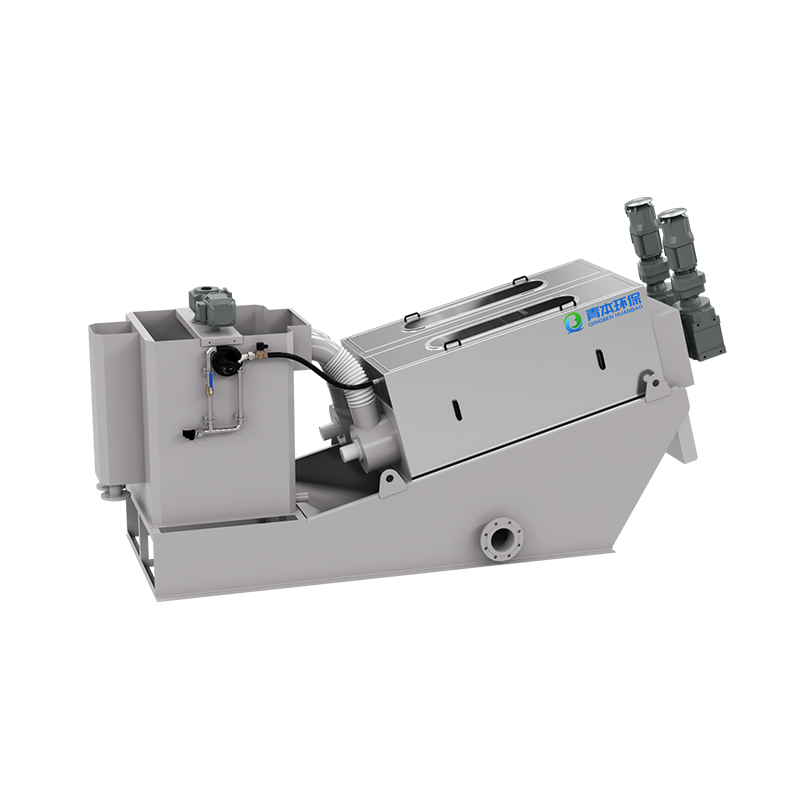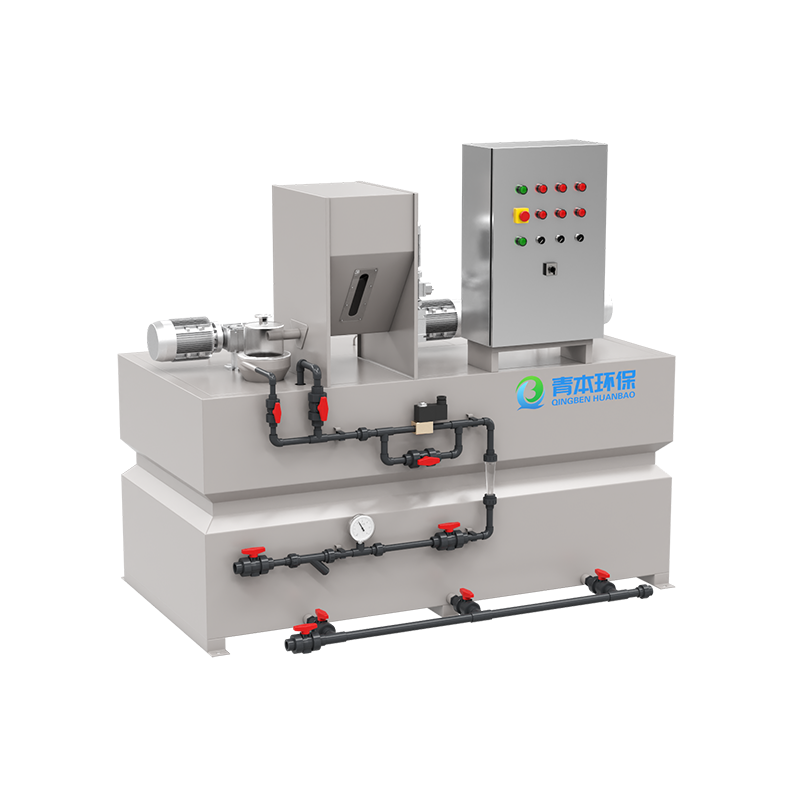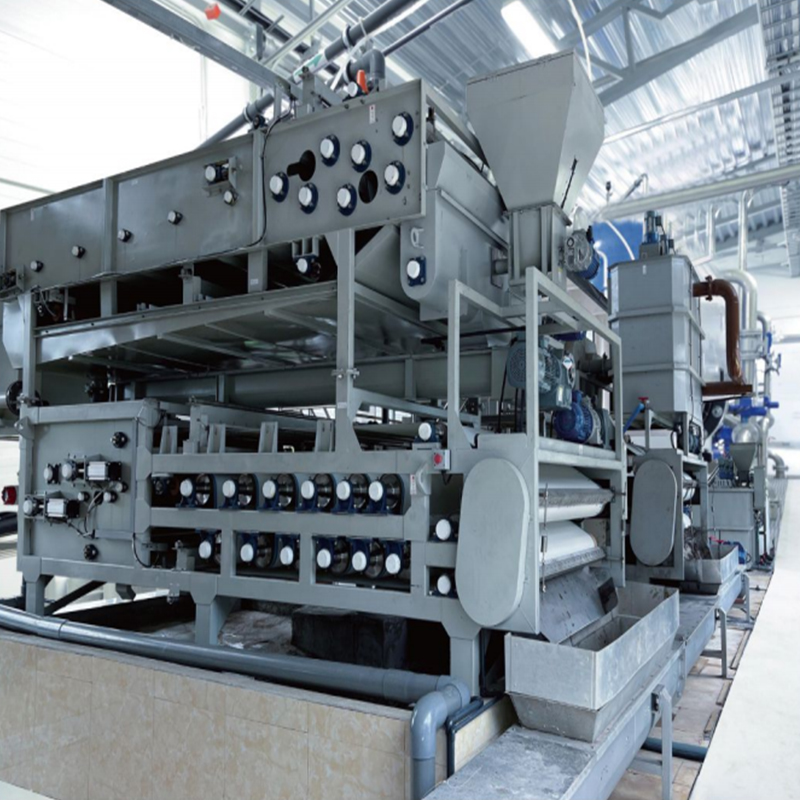Content
1. Special spiral structure: Solve the problem of wall adhesion
- Variable diameter spiral shaft design
Large pitch (80-100mm) in the front section quickly transports sludge to avoid inlet blockage
Gradual compression in the back section (pitch 30-50mm) realizes progressive dehydration
- Self-cleaning function
The friction between the spiral blade and the fixed ring automatically peels off the adhered sludge
Compared with traditional filter cloth equipment, the cleaning frequency is reduced by 80%
- Low speed operation: avoid secondary emulsification of sticky substances
Speed control (2-5r/min) is only 1/10 of the speed of the centrifuge to avoid high-speed shearing to damage the floc structure
Dynamic filtration principle Static pressure dehydration is generated through spiral propulsion to maintain the integrity of the sludge flocs
2. Precautions and operating specifications for the use of the spiral dehydrator
Key checks before operation
Mechanical system verification
Confirm that the gap between the spiral shaft and the fixed ring (recommended 0.8-1.2mm) meets the material characteristics
Check the reducer lubricating oil level (ISO VG220 gear oil, oil volume ≥ window 2/3)
Manually turn the wheel for 3-5 turns to ensure that there is no metal friction noise
Electrical system detection
The inverter parameter setting matches the sludge characteristics (usually 2-5Hz start, 3-8Hz operation)
The overload protection value is set to 110%-120% of the rated current
Key points of feed control
Sludge conditioning optimization
Viscous sludge needs to add 0.3%-0.5% cationic PAM (molecular weight above 12 million)
It is advisable to control the floc size at 3-5mm. Too large will cause a surge in the torque of the spiral shaft
Operation process monitoring
Key parameter warning Value
Main motor current: if it exceeds the rated value by 15%, it needs to be reduced immediately
Bearing temperature: if it is continuously >75℃, the machine should be stopped for inspection
Sludge moisture content: if the fluctuation exceeds ±3%, the back pressure plate needs to be adjusted
Abnormal situation handling
Sudden shutdown: first turn off the feed pump, and manually reverse the screw shaft 2-3 turns to discharge
Sludge is too thin: check the flocculation effect or reduce the gap between the movable rings (adjust 0.1mm each time)
Abnormal vibration: immediately stop and check the dynamic balance of the screw shaft (allowable vibration value ≤2.8mm/s)
Safety warning
Operation is strictly prohibited
Open the observation window during operation (there is a risk of material splashing)
Direct feeding of super-concentrated (>8% DS) sludge
Protection requirements
Explosion-proof motors are required when handling oily sludge
Operators need to wear noise-proof earmuffs (operating noise ≤85dB)
3. FAQ about Screw Press Sludge Dewatering Machine
- What types of sludge are suitable?
It can treat organic/inorganic mixed sludge from municipal sewage, food and beverage, chemical, printing and dyeing industries, and is also applicable to oily sludge (need to be equipped with a self-cleaning system).
The treatment concentration range is wide (2000mg/L~20000mg/L), and low-concentration sludge does not need to be pre-concentrated.
- How to choose a model?
According to the processing capacity (0.5~1840kg-DS/h) and sludge characteristics (such as fiber content, oil content), the model is matched, and non-standard requirements can be customized.
- What should be checked before starting the machine?
Confirm that the spray system is unobstructed (clear the blockage of the spray head), the solenoid valve is normal, and the running time is set to ≥20 seconds.
Check the gap between the spiral shaft and the ring (0.8-1.2mm), and manually turn the wheel to confirm that there is no obstruction.
- How to avoid blockage?
The feed amount of inorganic sludge needs to be controlled (avoid overload), and regular idling cleaning (idling for 30 minutes before stopping).
For minor blockages, try reversing the spiral shaft or strengthening the spray flushing. For serious blockages, the shaft needs to be removed for cleaning.
- Which parts need to be replaced regularly?
The floating ring and spiral shaft are consumables, and the replacement cycle depends on the characteristics of the sludge (generally 1-3 years).
- How to solve the problem of ring deformation or mud leakage?
Deformation is mostly caused by excessive feed or hard impurities, and a filter needs to be installed; mud leakage requires the replacement of the worn spiral shaft or repair with alloy plating.
Attachment: Quick self-check list
|
Problem phenomenon |
Possible cause |
Countermeasures |
|
No water from the sprayer |
Solenoid valve failure/pipeline blockage |
Check the power supply and clean the spray head |
|
Abnormal sound from the spiral shaft |
Bearing lacks oil or wears |
Stop for lubrication or replacement |
|
Fluctuation of solid content in the mud |
Poor flocculation effect/back pressure plate imbalance |
Re-adjust the reagent and gap |




















